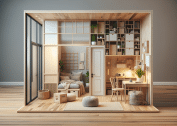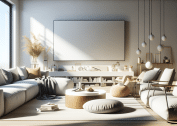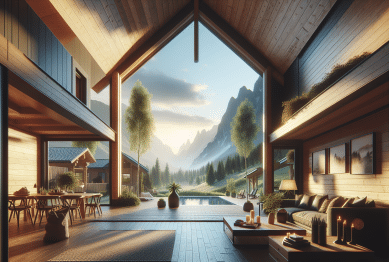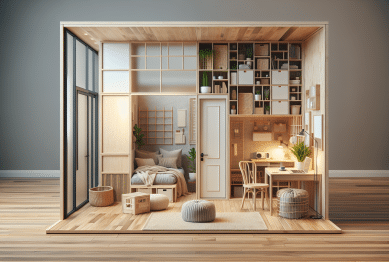Explore how the latest living room trends are changing modern lifestyles. From multi-functional furniture to eco-friendly décor, discover design ideas and entertainment setups that shape memorable experiences for every household.
Rethinking the Heart of the Home: Living Room Evolution
Over time, the living room has shifted from a formal sitting area to the social heart of the home. Today, people value spaces that adapt to their evolving needs. The surge in smart living room trends goes well beyond aesthetics—these changes impact daily routines, comfort, and even social interactions. Modular sofas, mobile partitions, and hybrid workspaces allow one room to handle many activities. It’s normal to see a cozy reading corner beside a sleek flat-screen TV, blurring the traditional lines between entertainment and relaxation. With smart design elements, living rooms transform easily, reflecting the lifestyle of those who live within them.
Flexibility is a defining principle. Tech integration, such as voice-controlled lighting and wireless charging tables, shapes a living space that’s both inviting and practical. Open-plan layouts continue to dominate, with fewer walls and more natural light. These designs foster communication, making it easy for guests to mingle or families to connect. Furthermore, hidden storage solutions keep clutter at bay, contributing to a relaxing environment. The latest home trends prioritize wellness, with ergonomic chairs, air-purifying indoor plants, and soft textiles for enhanced comfort. People are seeking living spaces that support mental well-being while offering visual appeal.
As design preferences shift, the living room reflects bigger lifestyle changes. The rise of remote work, home-based hobbies, and digital entertainment places new demands on this core space. Room dividers, soundproofing panels, and flexible lighting empower household members to create personal zones within a shared setting. This trend blends traditional comfort with cutting-edge innovation. Ultimately, the pursuit of a smarter living area mirrors society’s drive for convenience, sustainability, and better living experiences. Homeowners are choosing furnishings and layouts that not only match their taste but also respond to rapidly changing routines and needs.
Eco-Friendly and Sustainable Living Room Choices
Eco-conscious living is reshaping the future of home décor. Sustainable materials—like bamboo flooring, reclaimed wood tables, and recycled textile blankets—dominate new living room setups. Not only do these choices minimize environmental impact, but they also add texture and authenticity to interiors. Eco-friendly paint, free of harmful chemicals, is used for walls and furniture. Shoppers are increasingly mindful of the environmental footprint of their purchases and want living spaces that reflect these values. Natural fiber rugs, secondhand furniture, and minimalistic design also contribute to waste reduction. Sustainability isn’t just a buzzword—it’s a guiding principle in modern lifestyle and entertainment design.
Energy-efficient smart home devices are gaining momentum. LED lighting, programmable thermostats, and solar-powered accessories make the living room greener and reduce utility costs. Window placement matters, too. Designs that harness natural light cut energy usage while making rooms feel larger and warmer. Indoor plants—such as snake plants and peace lilies—not only beautify the space but also clean the air. These plants filter toxins and require little care, making them popular choices for busy households. Eco-aware living room trends bring nature indoors and highlight the connection between a comfortable home and a healthy planet.
The sustainable approach doesn’t sacrifice style. Many furniture brands now offer sleek, contemporary pieces crafted from renewable sources. Vintage shopping and DIY upcycling projects add character and reduce reliance on mass-produced goods. Choosing non-toxic, biodegradable textiles for throws, cushions, and curtains further enhances the ethical credentials of a living room. Homeowners are encouraged to explore product certifications such as GREENGUARD or FSC for wood. All these choices result in a healthier environment—both inside the living room and for the world beyond. Sustainable living room trends are shaping how modern entertainment and relaxation areas look and feel.
Technology and Entertainment Integration in Modern Living Rooms
The living room is now a hub of digital entertainment. Large-screen smart TVs, discreet soundbars, and streaming devices change how people enjoy films, music, and gaming at home. Voice assistants—like Google Home or Alexa—control playlists, lighting, and even temperature with simple commands. Hidden wiring, in-wall speakers, and wireless charging stations all contribute to a streamlined room where technology blends with design. Tabletop projectors and foldaway screens offer cinematic experiences without permanent installations, making advanced tech accessible even in compact homes.
Augmented reality (AR) and smart displays bring a futuristic edge. These innovations can guide mood lighting for movie nights or adapt the room’s ambiance to suit a gathering. Device compatibility is a top priority; homeowners want seamless connections between TV, smartphone, and speaker systems. Remote work arrangements influence entertainment choices, leading to versatile screens that double as video conference hubs during the day and family entertainment screens at night. Digital art frames cycle through curated images or personalized playlists, keeping the living room dynamic and visually interesting.
Beyond gadgets, digital management systems make life easier. Home automation lets users schedule routines, set ambient temperatures, and monitor home security—all from a centralized hub. Technology-driven furniture, such as sofas with built-in speakers or cooling cupholders, enhance comfort and user experience. The balance between entertainment and everyday living means tech placement is subtle yet powerful. Integrated solutions keep the room uncluttered, while smart technology remains at the user’s fingertips. This balanced approach ensures both style and substance in any living space.
Multi-Functional Furniture and Small Space Design
As urban living spaces shrink, the demand for multi-functional furniture surges. A single ottoman doubles as storage and seating. Convertible coffee tables adjust for work, dining, or socializing. Sofas with slide-out beds or adjustable backs redefine guest hosting and movie marathons. This innovation is not limited to tight apartments; even in larger homes, people want rooms that work harder without feeling crowded. Space-saving living room ideas cater to a growing audience seeking maximum utility without sacrificing comfort or design. Hidden desks or wall-mounted shelves optimize every square foot while maintaining visual harmony.
Compact, modular furniture adapts quickly as routines change. Stackable stools, nesting tables, and expandable sectionals let users tailor their living room for any event, from solo relaxation to family gatherings. Designs that fold, swivel, or roll allow quick transitions between work and play. This flexibility also helps in keeping the living area tidy, as modular elements can be moved or hidden away with ease. Smart storage—under-seat drawers, wall cubbies, dual-use benches—prevents clutter and supports the open-plan aesthetic now favored by many homeowners. Adaptive furniture brings a new sense of freedom to space management.
Durability and aesthetics are no longer at odds. Sustainable finishes and robust hardware mean these innovative pieces last for years. Homeowners increasingly look for furniture that offers value, longevity, and timeless appeal. Personal touches—bold colors, unique textures, or custom hardware—make multipurpose pieces stand out as conversation starters. When every item in the living room works harder, people enjoy a space that feels spacious, welcoming, and uniquely tailored to their lifestyle. Small-space design is about creativity, not compromise, and these smart solutions prove that limited square footage can inspire outstanding living.
Personalization and the Art of Storytelling Through Decor
No two living spaces need look the same. The surge in personalized home décor reflects a shift toward self-expression and emotional connection. Artworks, photos, and handpicked objects tell a story unique to each household. Gallery walls, curated book collections, and vibrant throw pillows showcase memories and aspirations. This trend isn’t about following rules, but about adopting pieces that genuinely resonate. Bold patterns, heritage textiles, and statement lighting all help to create a narrative with every design choice. Modern living room trends encourage homeowners to celebrate their own identity within their spaces.
Customization extends beyond color palettes. Many homeowners commission bespoke furnishings or upcycle vintage finds for a distinctive touch. The rise of DIY décor projects brings fresh creativity to the forefront. As a result, living rooms feel less like showrooms and more like sanctuaries filled with meaning. Personalized zones—like reading nooks or music corners—appear as routines and interests evolve. Technology also supports customization, with interactive photo frames, app-controlled lamps, and voice-activated playlists tailoring the ambiance to suit any occasion. Every surface becomes an opportunity to display what really matters.
This personal approach fosters belonging. By integrating meaningful décor, households create a sense of continuity between old traditions and new memories. Reclaimed wood mantels may recall a family’s origins, while vivid murals hint at travel adventures. The mix of sentimental objects and cutting-edge smart living room elements creates balance. Ultimately, decorating is about shaping a mood and telling a story that lasts. People want to come home to a space that feels inspiring, grounded, and wholly their own. That pursuit never goes out of style.
Wellness and Mindful Living in Entertainment Spaces
Well-being now takes center stage in modern entertainment and living rooms. Spaces are designed to lower stress, promote movement, and foster relaxation. Soft lighting, natural textures, and ergonomic seating become standard. Homeowners consider noise levels and air quality. Acoustic panels, air purifiers, and essential oil diffusers create environments suited for rest or entertainment. Wellness design often includes meditation corners or workout-friendly zones that look as inviting as any traditional lounge area. It’s a holistic philosophy that turns the living room into a retreat from life’s hectic pace.
The trend for biophilic design—blending indoor spaces with nature—persists. Large indoor plants, green walls, and water features support tranquility and cognitive function. Windows facing greenery are left unobstructed to maximize daylight and mood-boosting benefits. Thoughtfully selected art, muted color schemes, and tactile fabrics reduce sensory overload. These subtle touches help people recharge amid daily digital distractions. Mindful décor not only improves mental health but also elevates the entertaining experience for guests.
Every aspect of the living room can influence health. Simple habits—like removing shoes or using washable covers—boost hygiene. Flexible layouts encourage movement or group activities, inviting users to stretch, play, or gather. Integrated technology, when paired with calming design, ensures that digital entertainment supports rather than disrupts well-being. By focusing on holistic health and multi-sensory comfort, the living room becomes the foundation for happier, healthier lifestyles—one mindful design choice at a time.
References
1. American Society of Interior Designers. (n.d.). Home and Wellness Trends. Retrieved from https://www.asid.org/resources/resource-center/home-and-wellness-trends
2. Environmental Protection Agency. (n.d.). Indoor Air Quality in Homes. Retrieved from https://www.epa.gov/indoor-air-quality-iaq/indoor-air-quality-homes
3. U.S. Department of Energy. (n.d.). Energy Efficient Home Design. Retrieved from https://www.energy.gov/energysaver/design/energy-efficient-home-design
4. The Spruce. (n.d.). Sustainable Living Room Design Ideas. Retrieved from https://www.thespruce.com/sustainable-living-room-ideas-5183517
5. National Institutes of Health. (n.d.). Mindfulness for Your Health. Retrieved from https://newsinhealth.nih.gov/2016/06/mindfulness-your-health
6. Architectural Digest. (n.d.). The Latest Smart Home Technology Trends. Retrieved from https://www.architecturaldigest.com/story/latest-smart-home-technology









